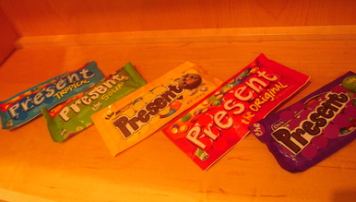Lewis Hyde opened The Gift: Imagination and the Erotic Life of Property by describing a rift in understanding between Pilgrims and
Indians. Because the latter expected that gifts would
stay in motion, the English called them “Indian givers,” meaning, those
who take gifts back.
 From
From
the Indian point of view, wrote Hyde, the Pilgrims might have been
called “white man keepers (or maybe capitalists, that is, people
whose instinct is to remove property from circulation, to put it in a
warehouse or museum or, more to the point for capitalism, to lay it
aside to be used for production).”
Northwest Coast Indians turned
this principle of gifts in motion into a banking system, known as the
potlatch. What was given away bestowed prestige and power, not what was hoarded.
Hyde:
The
Indian giver…understood a cardinal property of the gift: whatever we
have been given is supposed to be given away again, not kept. Or, if it
is kept, something of similar value would move on in its stead, the way
a billiard ball may stop when it sends another scurrying across the
felt, its momentum transferred. You may keep your Christmas present,
but it ceases to be a gift in the true sense unless you have given
something else away. As it is passed along, the gift may be given back
to the original donor, but this is not essential. In fact, it is better
if the gift is not returned but is given instead to some new, third
party. The only essential is this: the gift must always move. There are
other forms of property that stand still, that mark a boundary or
resist momentum, but the gift keeps going.
After the gift shop at the Henry Gallery failed and the space went dark, Seattle painter Matthew Offenbacher proposed turning it into an artist space. (Story here.) Different teams of artists run it on themes of their devising. Through Dec. 13 is The Gift Exchange by Claire Cowie, Sol Hashemi and Jason Hirata,
based on a come-one, come-all version of a potlach. Anyone can bring a
gift and take one, or bring several and take several. Cowie, Hashemi
and Hirata set a high standard for the exchange by seeding the original
stock with their work.
Since it opened Nov. 14, the audience
has risen to the occasion. Although some people tear open corners of
wrapped gifts and keep going until they find treasure, many, many
others bring treasures and take what they’re given in a blind exchange.
Not all gifts are blind. Some lack wrapping, in the interests of making
sure a gift goes to someone who will value it.
As a profile of the community, The Gift Exchange
proves that people raised in an individualistic, me-first, capitalistic
system can transcend their training and rise to higher ground. Since
the 1980s and accelerating ever since is the assumption that art equals
money, that its value can be translated into cash on the secondary
market. The Gift Exchange argues for an older, truer version of art, that it is in essence a form of grace. To all concerned, well done.
Note: Remember the hours. Thanks to budget cutbacks, the Henry is open only Thursdays to Sundays.



Great post. I don’t recall you saying so many critical things about Capitalism when you were the art critic at the Seattle Post-Intelligencer. Does having this blog mean you’re free to express your opinions and weren’t earlier?
Who says Seattle artists lack a sense of community? This project should make Portland jealous, and believe me, we aren’t jealous very often.
I’m not sure that art is grace, but I know it’s not money. I wish I could be in Seattle to see and participate in this show. Congratulations, Henry Gallery.
Love this story. Gives me that holiday feeling minus the horror.